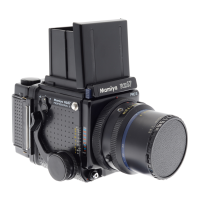
Do you have a question about the Mamiya RZ67 PRO II and is the answer not in the manual?
| Type | Medium Format SLR |
|---|---|
| Film Format | 120/220 |
| Lens Mount | Mamiya RZ Mount |
| Shutter Speed Range | 8 sec to 1/400 sec |
| Metering | TTL metering |
| Focusing | Manual |
| Flash Sync | 1/400 sec |
| Power Source | 6V 4LR44 battery |
| Exposure Modes | Manual |
| Viewfinder | Interchangeable |
| Image Size | 6x7 cm |
Explains the benefits of the 6x7 cm format for enlargement and quality.
Describes the revolving back for format changes and automatic viewfinder masking.
Details the bellows focusing system for precise focusing and close-ups.
Highlights Mamiya's reputation for lens quality and their advanced mount.
Covers the standard and optional finders and interchangeable focusing screens.
Discusses the availability of various film holders for different formats and films.
Explains the mirror lock-up function for vibration-free photography.
Describes the ease of making multiple exposures with a switch.
Mentions electronic interface, ISO dial, and lists modern features.
Details parts like R-M Lever, Cocking Lever, Distance, and Focusing Knobs.
Mentions the auto-changing format screen and its interchangeability.
Explains the collar's function for normal, locking, and emergency shutter release.
Describes contacts for electronic interface and lens alignment dots.
Details the dial for selecting speeds and other controls like Revolving Ring.
Explains film advance coupler, holder mount pins, and baffle.
Details the battery compartment cover and contacts for power winder.
How to raise, lower, fold, and use the magnifier on the finder.
Describes holder alignment, dark slide release, lock pins, and counter.
Covers film speed dial, back cover latch, dark slide, and spool mechanisms.
Explains film spool studs, start marks, and take-up spools.
Details flash sync, DOF controls, preview lever, time exposure lever, and scales.
Explains bayonet ring, lock pin, cocking pins, and shutter release socket.
Covers camera type, film holders, film types, negative size, and revolving back.
Details lens mount, shutter type, speed, sync, and multiple exposure.
Covers focusing screens, viewfinders, focusing method, winder, and battery types.
Lists safety warnings, dimensions, and weight of the camera.
How to open the chamber and insert batteries correctly.
Using shutter without battery and precautions for battery care.
Steps for mounting a lens, including mirror and shutter preparation.
How to cock the shutter on the lens itself before mounting.
Steps to detach a lens, including necessary precautions.
Warning about resting the camera on its back during lens changes.
How to raise, lower, fold, and use the magnifier on the finder.
Steps to detach and mount the finder onto the camera body.
How to replace magnifiers and focusing screens, with cautions.
Detailed steps for releasing the shutter, including R-M lever and speed dial settings.
Notes on film advance coupling and warning lamps for errors.
Normal operation, locking, and emergency shutter use of the collar.
Explains normal, multiple exposure, and revolving back positions of the lever.
Correct procedure for cocking the lever and potential issues.
Explains visual and audio signals for proper operation and error detection.
Details the meaning of green, red, and orange indicator lamps in the viewfinder.
Explains audio signals for shutter speed dial errors and low battery.
How to select shutter speeds, including Bulb, AEF, and RBL modes.
How to set the aperture and the automatic stop-down function.
Notes on using RB lenses with the RZ body, including flange distance.
Step-by-step guide for securely mounting the film holder onto the camera.
How to detach the film holder, including safety lock override.
How to remove the dark slide from a holder that is not on the camera.
Information on the interchangeability of film holder inserts.
Steps for opening the holder, inserting film, and winding to the start mark.
How to set film speed and notes on housing acceptance of film inserts.
How to advance film and set the film speed dial on the holder.
Two ways to advance film: film insert knob or camera cocking lever.
How the exposure counter indicates the first frame is ready.
How the exposure counter changes and advice on rapid advancement.
Steps to remove the film insert and prepare for future use.
Importance of checking the counter to prevent accidental film exposure.
How to focus using the focusing knobs until the image is sharp.
Using the lock lever to secure the focus position.
What to do if focus is lost and cautions about touching the knob.
How to rotate the back for different shooting orientations.
How viewfinder masks automatically change with the revolving back.
Warnings on gentle rotation and avoiding shutter release during rotation.
How to use the scale to determine film-plane-to-subject distance.
Using the preview lever and reading the depth-of-field scale on the lens.
How to perform bulb exposures with electronic control and auto-close.
How to set and perform time exposures using the T lever.
Step-by-step guide for creating double or multiple exposures.
Guidance for critical infrared photography focusing and correction table.
Steps for locking the mirror up to eliminate vibrations for sharp shots.
Cautions regarding cable release attachment and shutter release timing.
How to connect flash units and calculate aperture for flash photography.
Recommendations for tripod use and mounting the camera.
How to adjust exposure for close-up shots using a compensation scale.
Table showing area covered by different lenses at full bellows extension.
Procedures for attaching lenses when mirror is raised or shutter is released.
Lists the film holders compatible with the camera's back lock system.
Instructions for focusing RB lenses and setting shutter speeds.
Notes on using RB finders with RZ PRO II and associated cautions.
Common reasons why the shutter won't release or a lens can't be removed.
Reasons for film holder removal issues and general safety warnings.
Notes on winder compatibility, finder upgrades, and flash unit voltage safety.
Advice on protecting, storing, and cleaning the camera, lenses, and mirrors.
Recommends checking functions and outlines a maintenance schedule.